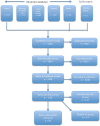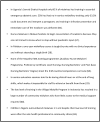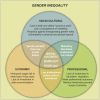What Prevents Quality Midwifery Care? A Systematic Mapping of Barriers in Low and Middle Income Countries from the Provider Perspective
- PMID: 27135248
- PMCID: PMC4852911
- DOI: 10.1371/journal.pone.0153391
What Prevents Quality Midwifery Care? A Systematic Mapping of Barriers in Low and Middle Income Countries from the Provider Perspective
Abstract
Background: Quality of care is essential for further progress in reducing maternal and newborn deaths. The integration of educated, trained, regulated and licensed midwives into the health system is associated with improved quality of care and sustained decreases in maternal and newborn mortality. To date, research on barriers to quality of care for women and newborns has not given due attention to the care provider's perspective. This paper addresses this gap by presenting the findings of a systematic mapping of the literature of the social, economic and professional barriers preventing midwifery personnel in low and middle income countries (LMICs) from providing quality of care.
Methods and findings: A systematic search of five electronic databases for literature published between January 1990 and August 2013. Eligible items included published and unpublished items in all languages. Items were screened against inclusion and exclusion criteria, yielding 82 items from 34 countries. 44% discussed countries or regions in Africa, 38% in Asia, and 5% in the Americas. Nearly half the articles were published since 2011. Data was extracted and presented in a narrative synthesis and tables. Items were organized into three categories; social; economic and professional barriers, based on an analytical framework. Barriers connected to the socially and culturally constructed context of childbirth, although least reported, appear instrumental in preventing quality midwifery care.
Conclusions: Significant social and cultural, economic and professional barriers can prevent the provision of quality midwifery care in LMICs. An analytical framework is proposed to show how the overlaps between the barriers reinforce each other, and that they arise from gender inequality. Links are made between burn out and moral distress, caused by the barriers, and poor quality care. Ongoing mechanisms to improve quality care will need to address the barriers from the midwifery provider perspective, as well as the underlying gender inequality.
Conflict of interest statement
Figures






Similar articles
-
What prevents midwifery quality care in Bangladesh? A focus group enquiry with midwifery students.BMC Health Serv Res. 2018 Aug 15;18(1):639. doi: 10.1186/s12913-018-3447-5. BMC Health Serv Res. 2018. PMID: 30111324 Free PMC article.
-
Pre-service and in-service education and training for maternal and newborn care providers in low- and middle-income countries: An evidence review and gap analysis.Midwifery. 2019 Nov;78:104-113. doi: 10.1016/j.midw.2019.08.007. Epub 2019 Aug 10. Midwifery. 2019. PMID: 31419781
-
Systematic review of barriers to, and facilitators of, the provision of high-quality midwifery services in India.Birth. 2020 Dec;47(4):304-321. doi: 10.1111/birt.12498. Epub 2020 Jul 25. Birth. 2020. PMID: 32713033
-
Is there a place for traditional midwives in the provision of community-health services?Ann Trop Med Parasitol. 1997 Apr;91(3):237-45. doi: 10.1080/00034989761094. Ann Trop Med Parasitol. 1997. PMID: 9229017 Review.
-
Barriers and facilitators to the implementation of midwife-led care for childbearing women in low- and middle-income countries: A mixed-methods systematic review.Midwifery. 2023 Jul;122:103696. doi: 10.1016/j.midw.2023.103696. Epub 2023 Apr 18. Midwifery. 2023. PMID: 37099826 Review.
Cited by
-
Midwifery centers as enabled environments for midwifery: A quasi experimental design assessing women's birth experiences in three models of care in Bangladesh, before and during covid.PLoS One. 2022 Dec 1;17(12):e0278336. doi: 10.1371/journal.pone.0278336. eCollection 2022. PLoS One. 2022. PMID: 36454986 Free PMC article.
-
Psychological and physiological stress and burnout among maternity providers in a rural county in Kenya: individual and situational predictors.BMC Public Health. 2021 Mar 6;21(1):453. doi: 10.1186/s12889-021-10453-0. BMC Public Health. 2021. PMID: 33676479 Free PMC article.
-
Applying a Power and Gender Lens to Understanding Health Care Provider Experience and Behavior: A Multicountry Qualitative Study.Glob Health Sci Pract. 2023 Nov 30;11(Suppl 1):e2200420. doi: 10.9745/GHSP-D-22-00420. Print 2023 Nov 30. Glob Health Sci Pract. 2023. PMID: 38035723 Free PMC article.
-
Quality midwifery care during the COVID-19 pandemic in Bangladesh: A focus group study with midwives, nurses, and midwifery educators.Eur J Midwifery. 2023 Dec 15;7:41. doi: 10.18332/ejm/174234. eCollection 2023. Eur J Midwifery. 2023. PMID: 38106465 Free PMC article.
-
Identifying disrespect and abuse in organisational culture: a study of two hospitals in Mumbai, India.Reprod Health Matters. 2018;26(53):36-47. doi: 10.1080/09688080.2018.1502021. Epub 2018 Aug 13. Reprod Health Matters. 2018. PMID: 30102132 Free PMC article.
References
-
- Renfrew MJ, McFadden A, Bastos MH, Campbell J, Channon AA, Cheung NG, et al. Midwifery and quality care: findings from a new evidence-informed framework for maternal and newborn care. The Lancet. 2014; 384; 9948; 1129–1145. - PubMed
-
- United Nations Population Fund. The state of the world’s midwifery 2011: delivering health, saving lives, New York, USA, United Nations Population Fund (UNFPA)2011.
-
- Horton R, Astudillo O. The power of midwifery. The Lancet. 2014; 384; 9948; 1075–1076. - PubMed
Publication types
MeSH terms
Grants and funding
LinkOut - more resources
Full Text Sources
Other Literature Sources
Miscellaneous

